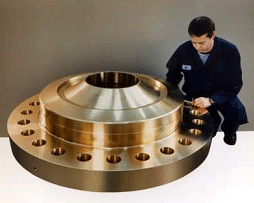Copper is Cool for Motors
Rotors Can Now Be Cast in Copper
Is a class of longer-lived, "super-premium" motors in the offing? According to the technicians who tested them, motors using new, die-cast copper rotors reduce electrical energy losses by 15% to 23% compared with motors using identical aluminum rotors, the current industry standard for squirrel-cage motors up to 200 hp or so. Pre-production runs of motors using the innovative copper rotors show 1.2% to 1.7% higher energy efficiency, depending on the rotor design.
Several major manufacturers of motors undertook the latest research and development program in conjunction with an earlier R&D program begun by CDA over five years ago. Presently, the program is funded by the International Copper Association.
Cooler is Better
 AA recently cast copper rotor being prepared for testing at the Formcast facility.
AA recently cast copper rotor being prepared for testing at the Formcast facility.Tests of the copper rotor showed they also reduced motor operating temperatures by 5°C to 32°C. As a general rule, for every 10-degree increase in motor operating temperature, the life of the motor’s insulation is cut in half. This means that the life of motors designed with copper rotors may be extended, with proper maintenance, by 50% or more over equivalent motors made with aluminum rotors.
The gain in motor efficiency was demonstrated to be consistent, irrespective of variables introduced into the die-casting process, such as pressure, shot speed and cooling rate. Consequently, from these data, it appears that the process of diecasting copper rotors can be quite reliable and robust.
Six different sizes and types of rotors were die cast by Formcast in Denver, Colorado, for five participating motor companies using pure, high-conductivity copper. Electrical efficiency tests were performed on an assortment of motors assembled with these copper rotors in accordance with IEEE Specification 112, Test Method B. The results from these tests exceeded DA expectations. Further improvements in process and rotor design, such as optimization of the conductor bars through the steel laminations, should extend copper's lead in efficiency. CDA will conduct additional evaluations with major manufacturers to fully develop and transfer the new rotor casting technology for motors that go into production.
For a more- detailed discussion of casting rotors out of copper, see the project’s dedicated Copper Motor Rotor section.
Also in this Issue:
- Copper for Faster Chips
- Promoting Efficient Motors
- Copper Protects Costly Gear
- Copper Building Materials Seen by Millions
- Attention Scrap Copper Purchasers
- Bronze Spiders Makes Manhattan Appearance
- Copper is Cool for Motors
